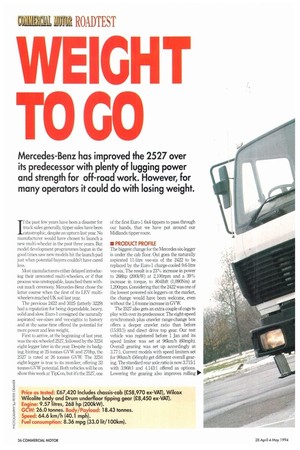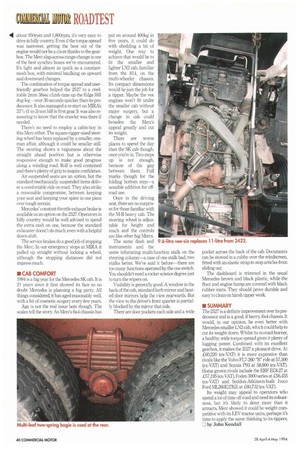WEI G HT
Page 38

Page 40

Page 42

If you've noticed an error in this article please click here to report it so we can fix it.
TO GO
Mercedes-Benz has improved the 2527 over its predecessor with plenty of lugging power and strength for off-roadwork. However, for many operators it could do with losing weight.
If the past few years have been a disaster for truck sales generally, tipper sales have been catastrophic, despite an upturn last year. No manufacturer would have chosen to launch a new multi-wheeler in the past three years. But model development programmes begun in the good times saw new models hit the launch pad just when potential buyers couldn't have cared less.
Most manufacturers either delayed introducing their unwanted multi-wheelers, or if that process was unstoppable, launched them without much ceremony. Mercedes-Benz chose the latter course when the first of its LEV multiwheelers reached UK soil last year.
The previous 2422 and 3025 (latterly 3229) had a reputation for being dependable, heavy, solid and slow. Euro-1 consigned the naturally aspirated vee-sixes and vee-eights to history and at the same time offered the potential for more power and less weight, First to arrive, at the beginning of last year, was the six-wheeled 2527, followed by the 3234 eight-legger later in the year. Despite its badging, hinting at 25 tonnes GVW and 270hp, the 2527 is rated at 26 tonnes GVW The 3234 eight-legger is true to its moniker, offering 32 tonnes GVW potential. Both vehicles will be on show this week at TipCon, but it's the 2527, one of the first Euro-1 6x4 tippers to pass through our hands, that we have put around our Midlands tipper route.
• PRODUCT PROFILE
The biggest change for the Mercedes six-legger is under the cab floor. Out goes the naturally aspirated 11-litre vee-six of the 2422 to be replaced by the Euro-1 charge-cooled 9.6-litre vee-six. The result is a 23% increase in power to 268hp (200kW) at 2,100rpm and a 39% increase in torque, to 8041bft (1,090Nm) at 1,200rpm. Considering that the 2422 was one of the lowest powered six-leggers on the market, the change would have been welcome, even without the 1.6 tonne increase in GVW.
The 2527 also gets an extra couple of cogs to play with over its predecessor. The eight-speed synchromesh plus crawler range-change box offers a deeper crawler ratio than before (15.93:1) and direct drive top gear. Our test vehicle was registered before 1 Jan and its speed limiter was set at 96knith (60mph). Overall gearing was set up accordingly at 3.77:1. Current models with speed limiters set for 901crn/h (56mph) get different overall gearing. The standard rear axle ratio is now 3.715:1 with 3.968:1 and 4.143:1 offered as options. Lowering the gearing also improves rolling II"
gradeability. Mercedes claims 42% for the 3.715:1 ratio, with 45% and 47% respectively for the 3.968:1 and 4.143:1. The lower ratios would give the chassis great flexibility in really hilly country.
The rest of the driveline and suspension is fundamentally unchanged. Drive is taken to the double drive bogie at the rear—cross and inter-axle diff locks are standard fittings. Suspension is by a parabolic, multi-leaf, twospring bogie, which looks sturdy enough for heavy-duty off-road work. Parabolic springs are also used at the front, which carries an antiroll bar in addition.
Mercedes obviously considers the chassis is sturdy enough without flitching—not surprising given its weight. The ladder-type frame carries a steel front bumper which should help to keep up appearances in the rough and tumble of off-road work Other changes include a re-sited vertical exhaust and standard automatic chassis lubrication. The exhaust has been moved closer to the cab, reflecting the narrower body/cab clearance that the 26-tonne limit seems to necessitate if axle loading problems are to be avoided. Our test vehicle was fitted with Wilcox Wilcolite body and Drum underfloor tipping gear.
• PRODUCTIVITY Overall fuel consumption of 8.36mpg (33.81it/100km) is not an outstanding result for
a 6x4 but the figure should be put in context. We have tested comparatively few 6x4 rigids at 26 tonnes GVW and only the 2527 and Maxter (see p44) in Euro-1 versions. On our 2421 test (CM 23-29 March 1989), we recorded 8.13mpg
(34.81it/100km) around the same route. So, compared to its predecessor, the 2527 carries an extra 1.6 tonnes and is powered by a smaller, more powerful Euro-1 engine. The Merc must earn some Brownie points for a marginal reduction in fuel consumption under those circumstances. Its overall average speed of 40.1mph (64.6krn/h) is roughly similar to its predecessor and comparable with other 6x4s.
Although the 2527 will carry an extra 1.6 tonnes over the 2422, it has put on weight in the process, presumably to cater for the higher gross weight. The fully fuelled chassis cab tipped the scales at 7.57 tonnes compared with 7.2 for the 2421 we tested. That still compares well with the Scania P93 we tested two years ago, but lighter chassis, such as the Foden 3300 series, start with around a half-tonne advantage.
• ON THE ROAD
A twist of the ignition key shows the 2527s most noticeable improvement over its predecessor. Instead of the cab-shaking chug of the naturally aspirated vee-six, the small vee-six sounds much more like the larger vee-six in the LEY range. It doesn't seem quite as refined as the 11 litre in the 1831 and 1834, but it is pleasantly smooth and free-revving like its big brothers.
Torque output is good in its class and as it doesn't drop below 7381bft (1,000Nrn) between 411 about 950rpm and 1,800rpm, it's very easy to drive in hilly country. Even if the torque spread was narrower, getting the best out of the engine would not be a chore thanks to the gearbox. The Mere slap-across range-change is one of the best synchro boxes we've encountered. It's light and almost as quick as a constantmesh box, with minimal baulking on upward and downward changes.
The combination of torque spread and userfriendly gearbox helped the 2527 to a creditable 2min 38sec climb time up the Edge Hill dog-leg—over 30 seconds quicker than its predecessor. It also managed a re-start on MIRAs 33% (1-in-3) test hill in first gear. It was also reassuring to know that the crawler was there if needed.
There's no need to employ a cabin-boy in this Mem either. The square-rigger-sized steering-wheel has been replaced by a smaller, oneman affair, although it could be smaller still. The steering shows a vagueness about the straight ahead position but is otherwise responsive enough to make good progress along a winding road. Roll is well contained and there's plenty of grip to inspire confidence.
Air-suspended seats are an option, but the standard mechanically suspended items deliver a comfortable tide on-road. They also strike a reasonable compromise, between keeping your seat and keeping your spine in one piece over rough terrain.
Mercedes' constant-throttle exhaust brake is available as an option on the 2527. Operators in hilly country would be well advised to spend the extra cash on one, because the standard exhauster doesn't do much, even with a helpful down-shift.
The service brakes do a good job of stopping the Mere. In our emergency stops at MIRA it pulled up straight without locking a wheel, although the stopping distances did not impress much.
• CAB COMFORT 1994 is a big year for the Mercedes SK cab. It is 21 years since it first showed its face so no doubt Mercedes is planning a big party. All things considered, it has aged reasonably well, with a bit of cosmetic surgery every few years.
Age is not the real issue here though. The scales tell the story. As Merc's 6x4 chassis has put on around 400kg in five years, it could do with shedding a bit of weight, One way to achieve that would be to fit the smaller and lighter LN2 cab, familiar from the 814, on the multi-wheeler chassis. Its compact dimensions would be just the job for a tipper. Maybe the vee engines won't fit under the smaller cab without major surgery, but a change in cab could broaden the Merc's appeal greatly and cut its weight There are worse places to spend the day than the SK cab though, once you're in. Two steps up is not enough, because of the gap between them. Full marks though for the folding bottom step—a sensible addition for offroad use.
Once in the driving seat, there are no surprises for those familiar with the M-B heavy cab. The steering wheel is adjustable for height and reach and the controls are like other big Mercs.
The same dash and instruments and the same infuriating multi-function stalk on the steering column—a case of one stalk bad, two stalks better. We've said it before—there are too many functions operated by the one switch. You shouldn't need a rocket science degree just to turn the wipers on.
Visibility is generally good. A window in the back of the cab, standard kerb mirror and heat ed door mirrors help the view rearwards. But the view to the driver's front quarter is partially blocked by the mirror that side.
There are door pockets each side and a wide pocket across the back of the cab. Documents can be stowed in a cubby over the windscreen, fitted with an elastic strap to stop articles from sliding out.
The dashboard is trimmed in the usual Mercedes brown and black plastic, while the floor and engine hump are covered with black rubber mats. They should prove durable and easy to clean on harsh tipper work.
• SUMMARY The 2527 is a definite improvement over its predecessor and is a good, if heavy, 6x4 chassis. It would, in our opinion, be even better with Mercedes smaller LN2 cab, which could help to cut its weight down. Whilst its no road-burner, a healthy, wide torque spread gives it plenty of lugging power. Combined with its excellent gearbox, it makes the /527 a pleasant drive. At .460,220 (ex-VAT) it is more expensive than rivals like the Volvo FL7-260 "B" ride at 57,500 (ex-VAT) and Scania P93 at 58,600 (ex-VAT). Home grown rivals include the ERF ECE327 at 457,195 (ex-VAT), Foden 3000 series at 456,455 (ex-VAT) and Seddon-Atkinson-built Iveco Ford ML260E27KE at 460,732 (ex-VAT).
Its weight may appeal to operators who spend a lot of time off-road and need its robustness, but it's likely to deter more than it attracts. Merc showed it could be weight competitive with its LEV tractor units, perhaps it's time to apply the same thinking to its tippers. El by John Kendall
























































































































